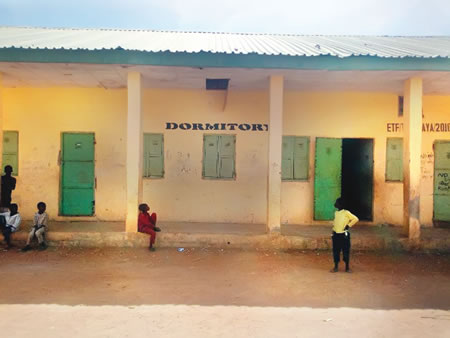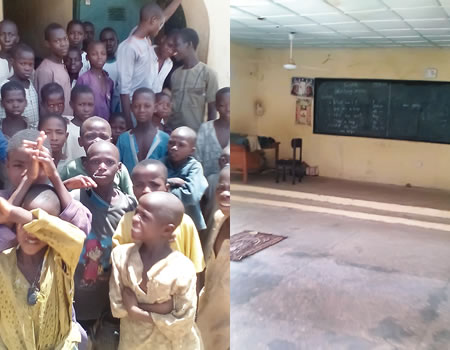
It was a grand initiative that was supposed to end years of inertia and take Almajiris off the streets. MUHAMMAD SABIU reports on the Almajiri schools and what has happened to them.
The Almajiri model schools programme, popularly known as Tsangaya School in the northern part of the country was conceptualised by former President Umaru Musa Yar’Adua but it was the administration of President Goodluck Jonathan that it was given life. The first of the many schools which were spread mostly across some states in the North was eventually inaugurated at Gagi village, Sokoto State on 10 April, 2012. The school took off with about 25 pupils.
The main objective of the government for embarking on the projects was to provide a lasting solution to the Almajiri syndrome that has bedevilled most parts of the North with millions of children said to be roaming the streets. The government at that time had proposed to establish an educational system that would combine both western and Islamic education. To this end, a whopping sum of N15bn was earmarked for the provision of dormitories, classrooms, vocational centres, language laboratories, staff quarters, kitchens, among others.
The schools were established in Kaduna, Kano, Kebbi, Niger, Bauchi, Zamfara, Borno and Sokoto and in two southern states of Rivers and Edo, where there is a large concentration of Northerners.
From Almajiri to conventional schools
Six years down the line the project has both succeeded and failed at several locations. In some places, the schools had fallen into disrepair such that the authorities concerned had converted them to conventional schools. In some other places, the schools had remained functional as they are being supported by host state governments.
The school today is 100 per cent tuition-free, including free feeding, and school uniform, all with the support of the state government under Governor Aminu Waziri Tambuwal. According to the school principal, Mallam Hussain Abdulahi Mutassabi, the pupils’ population had grown over the years with the figure now fixed at 260.
“We graduated the pioneer fifty students in 2017. Most of them are now in select secondary school, such as Sultan Atiku Secondary School; Shehu Abubakar Gumi Grammar School, among others. We would soon graduate another set of students immediately after resumption from our holiday,” he disclosed.
To some extent the Kebbi State School for the Almajiris is part of the success story. Established in 2014, the Almajiri School is located off NEPA Government Reserved Area on a large expanse of land with beautiful structures that makes it conducive to teaching and learning. It houses about 25 pupils, whose ages range from 5 to 10 years. When Sunday Tribune visited, they were seen clustering together, engaged in one form of play or the other.
The school is still at its infancy with the primary three classes being the most senior. There are well-ventilated classrooms and a large recreation hall in the school compound. There are only four teachers including the headmaster whose name was given simply as Malam Aliyu.
The two Almajiri schools in Kano State are located in Warawa and Kibiya local government areas. In fact, one could easily mistake the Warawa School for a private conventional school. The one in Kibiya is no less attractive. At the schools, no fees are charged, but virtually every other thing is provided by parents. In the dormitory, pupils sleep on mattresses and mats. There is also a dispensary and First Aid facility to take care of pupils who fall ill. The facilities are funded by the Parents/Teachers Association (PTA). There is also a staff quarter where a few staff members and the headmaster stay.
But that is as far as the success stories go. For example, the Kibiya School is not connected to public power supply, the school library, computer laboratory and skill training workshop had also been locked up due to unavailability of working materials to support the operations
Furthermore, there are other places where the Almajiri schools are hardly functional. An example is the one in Kaduna State. Sunday Tribune gathered that the permanent site of the school was first sited at Bilya Road in Rigasa, Igabi Local government area of the state.
However, it was gathered that after almost a year, the signboard was removed. An insider at the state Ministry of Education alleged that a former vice president, Namadi Sambo insisted that the school should be relocated to his local government in Zaria.
The insider further told Sunday Tribune that a land was provided for the school somewhere along Zaria-Kano highway, but since then, progress had been very slow. Latest findings revealed that the school had been abandoned, literally, as the structures had deteriorated with very few pupils attending. Most of the other students had gone back to the street.

Ironically, the two almajiri schools in Zamfara State – one at Talatan Mafara and the other at Gusau local governments respectively – have been converted to conventional schools. Sunday Tribune gathered that the Talatan Mafara school has been changed to Command Science Secondary School while the one in Gusau is now a Government Day Secondary School.
Officials of the state ministry of education were not forthcoming on the reason behind the decision. However, a staff of the ministry who wouldn’t like to be named revealed that the measure was taken because it was discovered that the structures were not utilised and were deteriorating.
A story of neglect
The story of the three schools in Bauchi State is that of neglect. Some of the structures in the schools located at Buzaye, along Jos Road for the Bauchi South Senatorial District, at Azare for the Bauchi North Senatorial district and Ningi for the Central senatorial district have become dilapidated due to neglect.
When Sunday Tribune visited Buzaye, it was discovered that since the commissioning about five years ago, the situation has remained the same. Nothing new has been added, while some of the structures are fast giving way and becoming dilapidated due to negligence.
There are at present over 400 pupils (Almajiris) brought from all the local government areas making up the Bauchi South Senatorial district. For the past two years, the school has been running on just 10-member teaching staff, four non-teaching staff and 11 casual staff. Sunday Tribune learnt that these members of staff had not been paid in the last 24 months, a situation that has grounded activities there.
Some of the members of staff who didn’t want to be identified for fear of disciplinary measures against them by government said the situation in the school is very pathetic as the pupils are made to go through hard times.
The pupils sleep on bare floor due to lack of sufficient mattresses despite the availability of double bunks. The roofs of some of the dormitories and classrooms have been blown off and left like that, thus exposing the children to the elements.
The pupils who spoke with Sunday Tribune said they need help from government to make the learning environment conducive for them, saying that they don’t want to go back to the streets to beg as there are dangers inherent in it.

Jafar and Annas, both class six pupils at the school want all the dilapidated structures repaired, including restoration of power supply so that the Computer Centre can function. The duo also want their feeding arrangements looked into as, according to them, they don’t have regular three square meals and sometimes eat without meat. They said all means of comfort are non-existent, just as the tough situation had made some of them to return to the street.
Against the backdrop of the noticeable decay in these schools, a report did the rounds that government was planning to shut them down. But the chairman of Bauchi State Universal Basic Education Board (SUBEB), Professor Yahaya Ibrahim Yero, denied such a plan. Professor Yero, who spoke through one of the board’s permanent members, Baba Lawan Hamza, said there was no truth in the claim as all the “pupils were reporting to schools and having their normal lessons as usual. Parents should always check any information regarding their children, from relevant authorities and refrain from relying on rumour mongers.”
Fears of the parents… and politics
A Director at the Zamfara State Ministry of Education, who pleaded for anonymity, gave the reasons why the state government decided to covert the Almajiri schools in the state to conventional government secondary schools. According to him, the system failed in the state because of socio-cultural fears of parents.
“After the Tsangaya schools were established, the enrolment dropped significantly. The ministry discovered that parents of the Almajiris believe that their children would be indoctrinated with the western values and all what they want is for their wards to acquire Islamic knowledgeable by a Mallam.
A parent who gave his name as Nasir Abubakar and resides in Damba village where one of the Tsangaya schools was established in Zamfara State confirmed the director’s statement. According to him “when the Almajiri school was established, only 10 Almajiris were registered but before you know what was happening there was no single Almajiri in the school.”
He added that ‘the community felt that instead of watching the edifice fall into decay, it was better to convert it to a normal conventional school.
Ahmed Abdulkadir, who runs an Almajiri school in Gusau, thinks differently. While faulting the claim that parents were afraid that their children would be wrongly indoctrinated, he blamed state governments in the North for the setbacks recorded in the Tsangaya programme. He noted that most of the northern state governors were not committed to the programme. Some of them, he said, chose to neglect the schools for political reasons. He added, however, that many people who could have enrolled their children in the school complained about their locations.
But to end the practice, government, it is said, must make conscious efforts to end or reform it. According to Professor Tukur Muhammed Baba, a sociologist, when a child roams the street he learns nothing but the way of the street. Therefore, unless government and stakeholders are fully determined, permanently taking the children off the street may be an uphill task.
“The Almajiri issue in Northern Nigeria, which most of us the Northern elite pay deaf ears to as if they [almajiris] are not there, is a big problem. They are not learning a trade to be vulcanizers, electricians, mechanics etc. The Quranic School that we think they are attanding, they only learn for a few hours. Thereafter, you find them roaming the street.
“What do you learn while roaming the street? You learn the way of the street. What is the way of the street? Hopelessness, despair, etc. In my opinion, we have a disconnect with our value chain and unless and until we go back to it, we continue to have a big problem (on our hands),” he stated.
But Liman Zakariya, an almajiri school proprietor, does not believe the private almajiri system is a total failure. He is of the view that if properly managed the Tsangaya Almajiri School would be a huge success.
Citing example with his school located in Kawo, Kaduna North Local Government of Kaduna State, the Islamic cleric disclosed he had over 200 almajiris under his care, saying his school had so far produced many Almajiris who are today proud holders of National Certificate of Education, National Diploma and Higher National Diploma. His school is one of the schools in the North which UBEC had selected to be running both Islamiyya and western education.
For him, therefore, the Almajiri School has done well and should stay. To this end, he called on the federal government to sustain the programme by providing enough funds to the schools.
A university lecturer, Dr Abubakar Zaria believes there is hope for the almajiri school system in spite of temporary setback. According to him, it is a laudable programme that will reduce the menace of Almajiri syndrome in our society, while calling on the federal government to continue with it.
With most of the Almajiri schools in a state of disrepair, it is not surprising that the streets are swarming with the underage pupils who should be in the schools. The question to ask is what has happened to the multibillion Naira endowment fund the Federal Government launched for the programme? Why have the schools been left to rot and the few pupils who enrol in them uncatered for? Only the government, both federal and states, can answer these questions. But rather than abating, the rank of the Almajiris in the North is swelling on a daily basis.
- Additional reports from ISHOLA MICHAEL, KOLA OYELERE, OLAKUNLE MARUF and AYODELE AJOGE.







